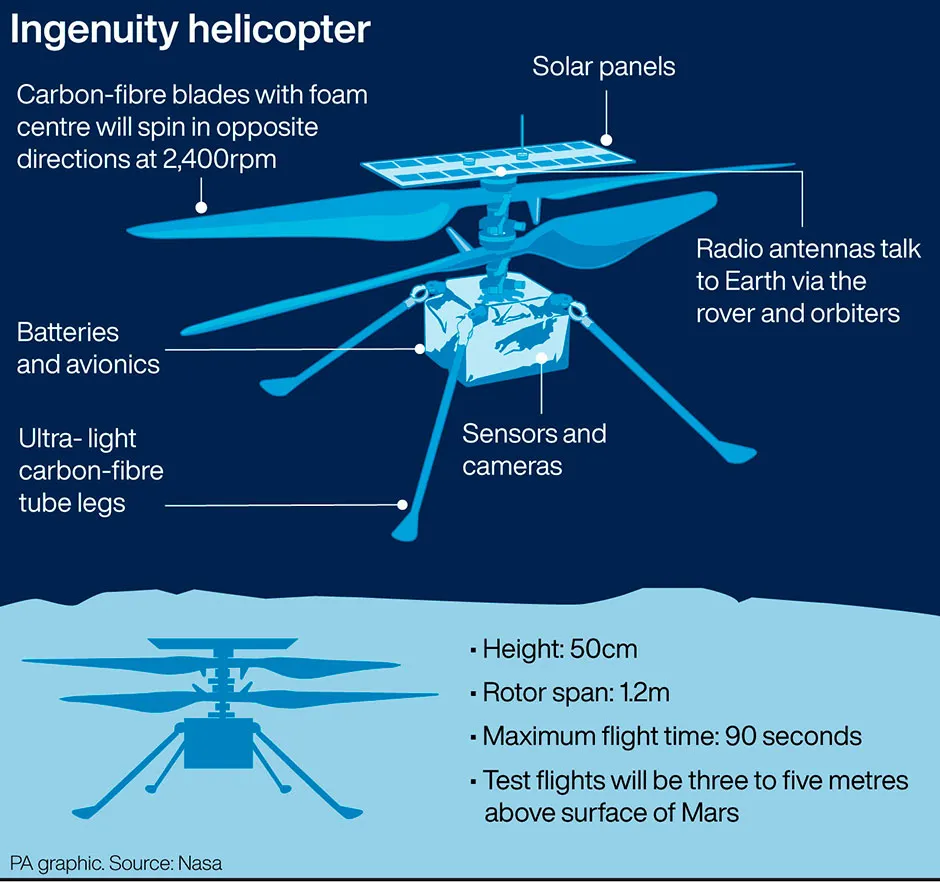NASA’s Ingenuity Mars helicopter has completed the first powered, controlled flight on another planet, the space agency has announced.
The small helicopter successfully took flight on the Red Planet on Monday, hovering in the air at about three metres, before descending and touching back down on the Martian surface.
The news was met by applause mission control, with Ingenuity’s chief pilot Håvard Grip announcing: “Ingenuity has performed its first flight – the first flight of a powered aircraft on another planet,” and this message was met by cheers and applause at mission control.
“We can now say that human beings have flown a rotorcraft on another planet," said MiMi Aung, Ingenuity Mars Helicopter project manager at NASA's Jet Propulsion Laboratory (JPL). “We’ve been talking for so long about our Wright brothers moment. And here it is.”
The aircraft is part of a technology demonstration – a project that aims to test a new capability for the first time.
Data from the first flight returned to Earth a few hours after the autonomous test.Pictures showed a shadow of Ingenuity hovering above the planet’s surface, and a video showed it grounded on the surface.
Read more about Ingenuity:
- Mars Ingenuity Helicopter: Why drones are the future of space exploration
- Ingenuity: How the Mars helicopter will fly on another planet
The Perseverance rover will provide support during flight operations, taking images, collecting environmental data and hosting the base station that enables the helicopter to communicate with mission controllers on Earth.
The rover's twitter account posted a video of the aircraft on the surface of the planet with its rotors spinning.It said: “You wouldn’t believe what I just saw. More images and video to come…”
Ingenuity arrived at the Jezero Crater on 18 February after an eight-month journey spanning nearly 300 million miles, tucked inside the belly of NASA's Perseverance rover.After the spacecraft landed, it dropped the drone on to the ground so Ingenuity could prepare for its first flight.
Standing just 50cm tall, the helicopter weighs 1.8kg on Earth, but is a mere 0.68kg on Mars because of the Red Planet’s lower gravity.It is armed with two rotors that spin in opposite directions to lift the drone off the ground.As well as the lower gravity, the helicopter faces the challenge of flying in the Martian atmosphere, which is about 100 times thinner than Earth’s.
As it is a technology demonstration, the helicopter does not have any scientific instruments on board.Ingenuity will attempt additional experimental flights, which will involve travelling further distances and increasing altitudes.
Altogether the helicopter will aim for up to five test flights within a 30 Martian-day (31 Earth-day) demonstration window.

It is designed to be mostly autonomous, so NASA will not be able to control the helicopter remotely.This is because of the distance between Earth and Mars: it takes more than 11 minutes to get a radio signal back to Earth.
The space agency said it will not be able to look at engineering data or images from each flight until well after the flight takes place.
“Flying on Mars is so challenging because its atmosphere at ground level is only 1 per cent of that on Earth, or as thin as it is on Earth at about 16km above sea level," said Dr Daniel Brown, an astronomy expert at Nottingham Trent University.“So this is not the usual altitude for helicopters to fly on Earth, with the altitude record held at about 12.4km.”
He added that it has to be ultra-light with the blades rotating “extremely fast”.
“To add to this, it has to also fly autonomously as we are far too far away on Earth to control it directly,” he said.
“The technology tested in this Mars copter could allow additional support to survey the terrain for rovers and humans alike in the future. It could also access difficult to access cliffs that cannot be reached by rovers. A whole new way to explore the alien terrain in our Solar System is now at our disposal."